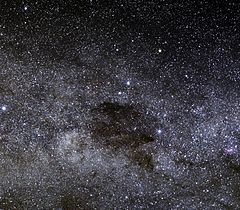Worek Węgla
 Ciemna mgławica Worek Węgla (ESO) | |
| Odkrywca | znany w starożytności |
|---|---|
| Dane obserwacyjne (J2000) | |
| Gwiazdozbiór | |
| Typ | |
| Rektascensja | 12h 31m 19s |
| Deklinacja | –63° 44′ 36″ |
| Odległość | |
| Charakterystyka fizyczna | |
| Wymiary | 7° × 5° |
Worek Węgla (ang. Coalsack) – nazwa ciemnej mgławicy, która ostro zaznacza się na tle Drogi Mlecznej w najmniejszym i najjaśniejszym zarazem gwiazdozbiorze, jakim jest Krzyż Południa. Mgławica leży obok gromady gwiazd zwanej Szkatułką. Rozciągając się do gwiazdozbiorów Centaura i Muchy, zajmuje obszar dwanaście razy szerszy od średnicy Księżyca w pełni, dzięki czemu dobrze widać ją nieuzbrojonym okiem i przez lornetkę[1].
Mgławica należy do najgęstszych dużych obłoków materii międzygwiezdnej, stąd jej nazwa. Światło gwiazd znajdujących się za nią jest osłabiane aż o dwie wielkości gwiazdowe.
Absorpcja światła w obłoku wykazuje niewielką selekcję, co świadczy o tym, że Worek Węgla prawdopodobnie składa się z większych cząstek pyłu. Mgławica leży ok. 600 lat świetlnych od Ziemi.
W kulturze niektórych plemion Aborygenów australijskich ta ciemna mgławica to „głowa emu” – tak interpretowano pasma pyłu tworzące ciemne kształty na tle dysku Galaktyki, na odcinku między Krzyżem Południa a gwiazdozbiorem Skorpiona. To swego rodzaju nietypowa konstelacja – wyobrażona na podstawie układu nie gwiazd, lecz ciemnych obłoków materii międzygwiazdowej[2].
Przypisy
Linki zewnętrzne
- Worek Węgla w SEDS.org (ang.)
- Worek Węgla w bazie SIMBAD (ang.)
- Kosmiczny worek węgla. [w:] eso1539pl – Zdjęcie prasowe [on-line]. ESO, 2015-10-14. [dostęp 2015-10-15].
Media użyte na tej stronie
Autor: NASA Hubble Space Telescope, Licencja: CC BY 2.0
This stunning image captures a small region on the edge of the inky Coalsack Nebula, or Caldwell 99. Caldwell 99 is a dark nebula — a dense cloud of interstellar dust that completely blocks out visible wavelengths of light from objects behind it. The object at the center of the image is a (much smaller) protoplanetary nebula. The protoplanetary nebula phase is a late stage in the life of a star in which it has ejected a shell of hydrogen gas and is quickly heating up. This stage only lasts for a few thousand years before the protoplanetary nebula’s central star reaches roughly 30,000 Kelvin. At this point, the central star is producing enough energy to make its surrounding shell of gas glow, becoming what’s known as a planetary nebula.
The observations that comprise this image were made using Hubble’s Advanced Camera for Surveys in visible and infrared wavelengths. Astronomers took these observations to learn more about the evolution of protoplanetary nebulae into planetary nebulae.
Caldwell 99 is a very prominent object in the southern night sky. On a clear night, it can be spotted easily with the naked eye as a dark patch, void of stars, next to the Southern Cross in the constellation Crux. It is easiest to spot in the Southern Hemisphere during the autumn. (Northern Hemisphere observers will want to be positioned near the equator and look for it in the springtime.)
Having been viewed by stargazers in the Southern Hemisphere for millennia, Caldwell 99 has no discoverer, but Europeans first learned of it from Spanish explorer Vicente Yáñez Pinzón in 1499. Caldwell 99 is located approximately 600 light-years from Earth and is about 100 light-years across.
Credit: NASA, ESA, and R. Sahai (Jet Propulsion Laboratory); Processing: Gladys Kober (NASA/Catholic University of America)
For Hubble's Caldwell catalog website and information on how to find these objects in the night sky, visit: <a href="https://www.nasa.gov/content/goddard/hubble-s-caldwell-catalog" rel="noreferrer nofollow">www.nasa.gov/content/goddard/hubble-s-caldwell-catalog</a>Autor: ESO/S. Brunier, Licencja: CC BY 4.0
The Coalsack is one of the most prominent dark nebulae visible to the unaided eye. A beautiful sight in the southern sky, the Coalsack casts a dark silhouette against the Milky Way’s bright stripe of stars. The Coalsack is located approximately 600 light-years away from Earth in the southern part of the constellation of Crux (the Southern Cross).
This seemingly starless dark patch is actually an opaque interstellar dust cloud that obscures the light of the background Milky Way stars. Dust grains in the cloud redden the starlight that reaches us by absorbing blue light preferentially, so that the red stars shimmering in the northern and darkest part of the Coalsack appear more crimson than they would in the absence of this dust.
The first European to see this remarkable object was probably the Spanish navigator and explorer Vincente Yanez Pinzon when he sailed to the South American coast in 1499. The Coalsack earned the nickname "Black Magellanic Cloud” in the 16th century, apparently rivalling the prominence of the Large and Small Magellanic Clouds, the two dwarf irregular galaxies that shine brightly in the skies of the Southern Hemisphere. The Incas tell that the god Ataguchu, in a fit of temper, kicked the Milky Way and a fragment flew off, forming the Small Magellanic Cloud where it landed on the sky, and leaving the black mark of the Coalsack behind. Beware of Inca gods in a bad mood!
Another famous sight seen from southern latitudes — though it can creep into view in tropical northern latitudes — is the Southern Cross, or Crux. This cross-shaped constellation has assumed great significance in the cultures of the Southern Hemisphere, even as far back as prehistoric times. So distinctive and evocative is the Southern Cross that the national flags of Australia, Brazil, New Zealand, Papua New Guinea, and Samoa all include a representation of it. The European Southern Observatory (ESO) has also acknowledged the significance of Crux as the foremost constellation of the southern skies, and has proudly incorporated the cross-shaped symbol into the ESO logo. Its Mapudungun name (that is, in the language of the native Chilean Mapuche population), Melipal, was given to the third Unit Telescope of the VLT on Paranal.Autor: Szczureq, Licencja: CC BY-SA 4.0
Gwiazdozbiór Krzyża Południa. Mapa została stworzona przy pomocy programu PP3 autorstwa Torstena Brongera. Wersję wektorową stworzył Szczureq według wzoru z wersji rastrowej, której autorem jest BlueShade.




